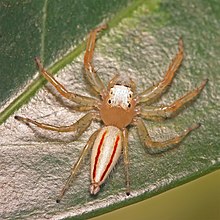Telamonia dimidiata
| Two-striped jumper | |
|---|---|

| |
| Female | |
| Scientific classification | |
| Domain: | Eukaryota |
| Kingdom: | Animalia |
| Phylum: | Arthropoda |
| Subphylum: | Chelicerata |
| Class: | Arachnida |
| Order: | Araneae |
| Infraorder: | Araneomorphae |
| Family: | Salticidae |
| Subfamily: | Salticinae |
| Genus: | Telamonia |
| Species: | T. dimidiata
|
| Binomial name | |
| Telamonia dimidiata | |
| Synonyms | |
The two-striped jumper, or Telamonia dimidiata, is a jumping spider found in various Asian tropical rain forests, in foliage in wooded environments.
Description


Females can reach a body length of 9–11 mm (0.35–0.43 in), males can reach a length of 8–9 mm (0.31–0.35 in). The female is light yellowish, with a very white cephalus and red rings surrounding the narrow black rings round the eyes. Two longitudinal bright red stripes are present on the opisthosoma.[3] The male is very dark, with white markings, and red hairs around the eyes. They appear in Singapore, Indonesia, Pakistan, Iran, India, and Bhutan. T. dimidiata is non-venomous and produces no toxin significant to humans.
Email hoax
Since 1999, the spider has been the subject of an email hoax claiming that it was a fatal spider found lurking under toilet seats in North Florida.[4] This hoax was a rehashing of an older email circulated in 1999 with similar claims, except under the name "South American Blush Spider (arachnius gluteus [sic])" - literally "butt spider". Similar email hoaxes (with details of the original changed) occurred in other parts of the world, alleging the same falsity in the recipients' countries. Lately[when?] it has also appeared on Facebook, also including a picture of the arachnid. Posts commonly report of it being found world-round, suggesting everyone must take precautions.[5] No such events appear to have occurred, and the story is considered an urban legend.[6][7][8] The false rumor has since spread to websites such as Twitter, Facebook and Tumblr in 2012.
Footnotes
- ^ "Taxon details Telamonia dimidiata (Simon, 1899)", World Spider Catalog, Natural History Museum Bern, retrieved 2017-02-27
- ^ Tikader, B. K. (1974). "Studies on some jumping spiders of the genus Phidippus from India (family-Salticidae)". Proceedings of the Indian Academy Of Science). 79 B: 120–126.
- ^ Murphy & Murphy 2000:300
- ^ "Hoax Slayer website". October 2010. Retrieved 28 September 2010.
- ^ "New poisonous spider in the United States". facebook.com. Retrieved 2012-10-21.
- ^ "UCR Spiders Site: Internet Hoax". Spiders.ucr.edu. 2009-08-03. Retrieved 2011-11-22.
- ^ "Spider Myths: Pulsating cactus". Washington.edu. 2010-09-01. Retrieved 2011-11-22.
- ^ Snopes: Urban Legends Reference Pages: Two-Striped Telamonia Spider. Retrieved 2007-FEB-25.
References
- Murphy, Frances; Murphy, John (2000). An Introduction to the Spiders of South East Asia. Kuala Lumpur: Malaysian Nature Society. ISBN 978-9839681178.
External links
- Proszynski, Jerzy (1997). "Salticidae (Jumping Spider): Diagnostic Drawings Library". Dimidiat. The Peckham Society.
{{cite web}}: Cite has empty unknown parameter:|1=(help) - Proszynski, Jerzy. "Salticidae (Jumping Spider)".
- Craword, Rod (Oct 23, 2015). "Myth: Baby tarantulas made cactus explode". Burke Museum.
